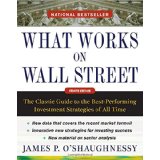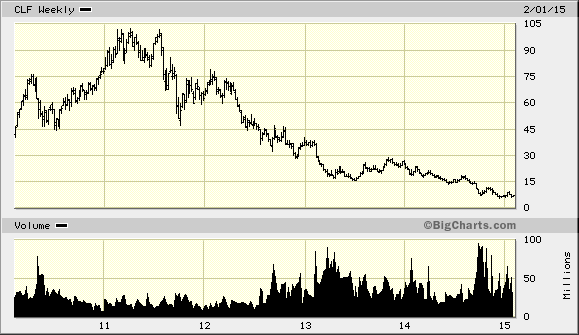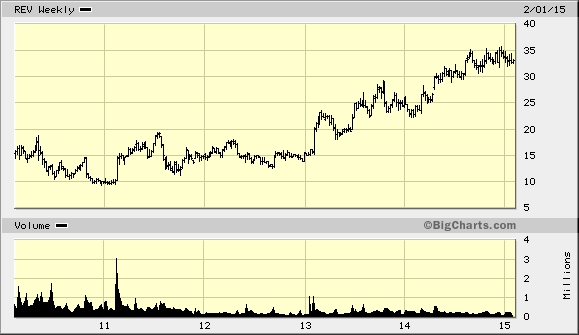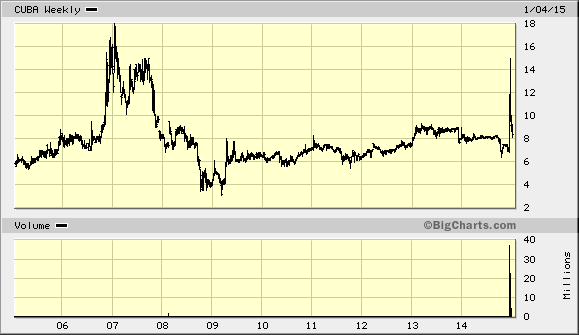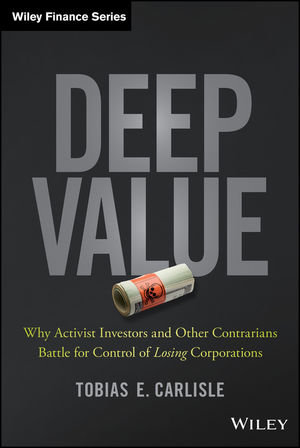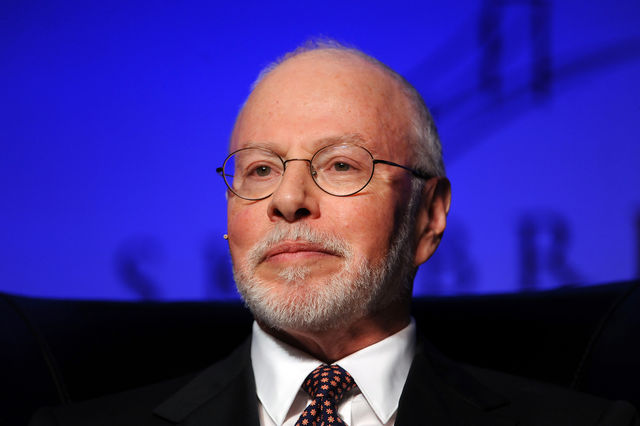Chimps Managing (30-second video) and Sales are down
Why can’t 70% of professional money managers beat chimps?
High fees/costs, index hugging, inconsistency, overconfidence in their ability to be above average, lovers of stories, herding, and the institutional imperative? Don’t forget incentives that differ from achieving performance like asset gathering. See the case study at the end of this post.
We left off with a reader asking why do money managers do better or follow a deep value approach? http://wp.me/p2OaYY-2IZ
One goal of our Deep Value journey is to find a method that suits us. This method should have a large base case rate of beating an index over a long period of time, say fifty years. The lesson learned so far—I hope—is that CHEAPNESS wins whether that is price to book value, price to sales, price to cash flow. My recent reading of the most recent 4th Edition of What Works on Wall Street shows that high EBITDA-to-EV has beaten out Price-to-Sales (3rd Edition) What Works on Wall Street, Third Edition as the best metric as a value factor. However, combined with quality of earnings metrics, it performs even better or about 18% to 19% per year since 1964 to 2009. Our goal is to put the odds on our side and CONSISTENTLY play the odds through thick and thin. Our other edge is to realize how flawed our thinking is and thus we build protection against ourselves by developing a disciplined approach.
What Works: Notes from Joel Greenblatt’s class 2002:
Read: What Works on Wall Street by James P O’Shaughnessy. He started a fund in 1996-1997 but he underperformed the market by 25% and after three years in business of underperforming he sold his company at the bottom of the cycle. The guy who wrote the book quit his system! It seems like it is easy to do, but it is not easy to do.
This book, What Works on Wall Street, has born out its wisdom. The two funds that are patented that follow his strategy have been phenomenal. HFCGX is the patented fund based on his top idea of Cornerstone Growth; over the last 5 years it has had an average return of 13.44% per year vs. the Vanguard 500’s -2.01% per year (6/1/00 through 5/31/05). HFCVX is the patented fund based on his 2nd to best idea of Cornerstone Value; over the last 5 years it has had an average return of 6.47% per year vs. the Vanguard 500’s -2.01% per year (6/1/00 through 5/31/05).
The most interesting point is that the author points out those investors often are too emotionally involved to have the discipline to see the strategy through. Not only did the first reviewer bash the book because he did like the returns strategy JUST one year after the book came out, but Mr. O’Shaughnessy sold the funds to Hennessy Funds at the end of 1999 after it failed to surpass the returns of the bubble that soon after collapsed. Seven years after it was published an investor would be much wealthier had they followed the books top strategy instead of the investors who dog-piled onto the stocks of the market’s bubble.
We are going to try to understand why it works. Why it has to work over time. That is the only way you can stick it out. The math never changes: 2 + 2 = 4. That is the level of your understanding I want you to have by the time we are done. If I get that right, forget all this other stuff and noise, I will get my money. No genius required. Concepts will make you great and your ability to STICK IT OUT.
There is a lot of experience involved in valuation work, but it doesn’t take a genius or high IQ points to know the basic concepts. The basic concepts are what will make you the money in the long run. We are all capable of doing the valuation work.
—
Notes from the 4th Edition of What Works on Wall Street
Why Indexing Works
Indexing works because it sidesteps flawed decision-making and automates the simple strategy of buying the big stocks that make up the S&P 500. The mighty S&P 500 consistently beat 70 percent of traditionally managed funds over the long-term by doing nothing more than making a disciplined bet on large capitalization stocks.
Money Management Performance
Past records of most traditional mangers cannot be predictive of future returns because their behavior is inconsistent. You can’t make forecasts based on inconsistent behavior.
Common Sense Prevails
We now have the ability to empirically compare different investment strategies and their ongoing performance over time. What you will see in coming chapters is that almost all of them are deeply consistent with what common sense would tell you was true. Strategies that buy stocks that are selling at deep discounts to cash flow, sales, earnings , EBITDA-to-enterprise value (Yeah, but don’t forget MCX), and so on do extraordinary better than those that are willing to buy stocks with the richest valuation. WE will be sensitive to data mining.
Does Complexity Imply Value Simple works best–I suggest you read!
Systematic, structured investing is a hybrid of active and passive management that automated the buy and sell decisions. If a stock meets a particular criteria, it’s bought. If not, not. No personal, emotional judgments enter into the process. Essentially, you are indexing a portfolio to a specific investment strategy and, by doing so, uniting the best of active and passive investing. The disciplined implementation of active strategies is the key to performance. Traditional managers usually follow a hit-and-miss approach to investing. Their lack of discipline accounts for their inability to beat simple approaches that never vary from the underlying strategy.
The ONE thing that unites the best money managers is consistency.
Successful investing requires, at a minimum, a structured decision-making process that can be easily defined and a stated investment philosophy that is consistently applied.
Goeth said, “In the realm of ideas everything depends on enthusiasm; in the real world, all rests on perseverance.” While we may intellectually understand what we should do, we usually are overwhelmed by our nature, allowing the intensely emotional present to overpower our better judgment.
Human Judgment is limited
Why models beat humans
Models beat the human forecasters because they reliably and consistently apply the same criteria time after time. It is the total reliability of application of the model that accounts for its superior performance.
We are ALL above average.
Base rates are boring
We prefer gut reactions and stories to boring base rates.
Stocks with low PE ratios outperformed the market in 99 percent of all rolling 10-year periods between 1964 and 2009.
The best way to predict the future is to bet with the base rate that is derived from a large sample.
Base rates are boring while experience is vivid and fun. Never mind that stocks with high P/E ratios beat the market less than 1 percent of the time over all rolling 10-year periods between 1964 and 2009.
Montier in his book, Value Investing writes: “One of the recurring themes of my research is that we just can’t forecast There isn’t a shred of evidence to suggest that we can.
We prefer the complex and artificial to the simple and unadorned.
Nowhere does history indulge in repetition so often or so uniformly as in Wall Street. When you read contemporary accounts of booms or panics, the one thing that strikes you most forcibly is how little either stock speculation or stock speculators today differ from yesterday. The game does not change and neither does human nature.—Edwin Lefevre.
Brain Research
Because of the interrelated nature of the emotional and rational centers of our brain, we will never be able to fully overcome our tendency to make irrational choices. Simply being aware of this problem does not make it go away. To break from our human tendencies to chase performance and perceive patterns where there are none, we must find an investment strategy that removes subjective, human decision-making from the process and relies instead on smart, empirically proven systematic strategies. We can become wise by realizing how unwise we truly are.
Rules of the Game
It is amazing to reflect how little systematic knowledge Wall Street has to draw upon as regards the historical behavior of securities with defined characteristics. –Ben Graham
Richard Brealey, a respected data analysis, estimated that to make reasonable assumptions about a strategy’s validity (95% confidence level or statistically relevant) you would need 25 years of data.
Short periods are valueless
Consider the “soaring sixties” when the go-go growth managers of that era switched stocks so fast that they were called gunslingers. The go-go investors of the era focused on the most rapidly growing companies without even considering how much they were paying for every dollar of growth. Between Jan 1, 1964, and Dec. 31, 1968, $10,000 invested in a portfolio that annually bought the 50 stocks in the Compustat data base with the best annual growth in sales soared to $33,000 in value , a compound return of 27.34 % a year. That more than doubled the S&P 500’s 10.16% annual return, which saw $10,000 grow to just $16,200. Unfortunately, the strategy went on to lose 15.7% per year for the following five years compared to a gain of two percent for the S&P 500.
Had this same hapless investor had access to long-term returns, he would have seen that buying stocks based just on their annual growth of sales was a horrible way to invest—the strategy returns just 3.88 percent per year between 1964 and 2009. Of course, the investor received similar results if he repeated the experiment between 1995 and 1999 and then the next five years.
EBITDA to EV was the best on an absolute basis for all the individual value factors we examine from 1964 to 2009 such as price to cash flow, price to earnings, etc.
EV/EBITDA in the lowest decile (the most EBITDA per EV) generated a 16.58% CAGR vs. 11.22% for the All Stocks universe with a standard deviation of returns of 17.71 percent, more than 1 percent below that of All stocks, 18.99 percent. The worst five-year period for the metric was 2000 during the Internet Mania. These ups and downs for a strategy are all part of the bargain you must strike with yourself as a strategic investor. Pages 103 to 124 in What Works (4th Ed.) The EV/EBITDA in the highest decile (the most “expensive) did the worst of all the value metrics studied!
EV works well as a guide to under-and-over valuation when contrasted to EBITDA, SALES, and Free cash flow.
Price to book value ratios are a long-term winner with LONG periods of underperformance.
Accounting Ratios can help identify higher quality earnings:
- Total accruals to total assets
- Percentage change in net operating assets (NOA)
- Total accruals to average asses.
- Depreciation expense to capital expense.
We are looking for stocks with high earnings quality.
Accounting variables mater. How companies account for accruals, how quickly they depreciate capital expenses and their additions to debt all have a serious impact on the health of their stock price.
Successful investing relies heavily on buying stocks that have good prospects, but for which investors currently have low expectations. Stocks with great earnings gains and high net profit margins are basically high expectations stocks.
History shows that using high profit margins as the SOLE determinant for buying a stock leads to disappointing results. The only lesson here is that it is best to avoid stocks with the lowest net profit margins.
A Case Study in Why Money Managers Lose Even With a Winning Hand
- Winning Stock Picker’s Losing Fund
Value Line Research Service Has Beaten Market Handily, But Its Own Fund Suffered By Jeff D. Opdyke and Jane J. Kim Staff Reporters of THE WALL STREET JOURNAL Updated Sept. 16, 2004 12:01 a.m. ET
Value Line Investment Survey is one of the top independent stock-research services, touted for its remarkable record of identifying winners. Warren Buffett and Peter Lynch, among other professional investors, laud its system.
But the company also runs a mutual fund, and in one of Wall Street’s odder paradoxes, it has performed terribly. Investors following the Value Line approach to buying and selling stocks would have racked up cumulative gains of nearly 76% over the five years ended in December, according to the investment-research firm. That period includes the worst bear market in a generation.
Why the Fund Lagged
- Past managers bought stocks that in some cases were well below the company’s top-rated choices, hurting performance.
- Style drift: The fund has swung among small-, mid- and large-cap shares.
- High turnover of fund managers meant little consistent investment discipline.
By contrast, the mutual fund — one of the nation’s oldest, having started in 1950 — lost a cumulative 19% over the same five years. The discrepancy has a lot to do with the fact that the Value Line fund, despite its name, hasn’t rigorously followed the weekly investment advice printed by its parent Value Line Publishing Inc. It also highlights the penalty investors often face when their mutual fund churns its management team and plays around with its investing style. In fact, late last night the person running the fund, Jack Dempsey, said that as of yesterday he had been reassigned and no longer had responsibility for managing the assets. Value Line couldn’t be reached to comment.
Most of all, the discrepancy between the performance of the fund and the stocks it touts shows that investors don’t always get what they think they’re buying in a mutual fund. For even though Value Line’s success is built around stocks ranked No. 1 by the company’s research arm, the fund’s managers have in recent years dipped into stocks rated as low as No. 3.
Ironically, even while Value Line’s own fund struggles to match the Value Line Investment Survey’s success, an independent fund company that licenses the Value Line name is doing much better with Value Line’s investment approach.
The First Trust Value Line 100 closed-end fund, run by Lisle, Ill.,-based First Trust Portfolios, adheres far more rigorously to Value Line’s investment principles, owning only the top-rated stocks.
Each Friday, First Trust managers log on to the Value Line site to download the week’s list of Value Line’s 100 most-timely stocks. During the next week, they sell the stocks that have fallen off the list and buy those that have been added. The result: Since its inception in June 2003, the First Trust Value Line fund’s net-asset value is up 12.4%, slightly better than the 11.6% gain the Standard & Poor’s 500-stock index posted in the same period.
Value Line’s own fund, meanwhile, gained 3.1% in that same time. Because the fund has been such a laggard in recent years, investors have been walking away. Assets in the fund — in the $500 million range as recently as 1999 — are now less than $200 million, though some of that stems from market losses.
Part of the underperformance stems from previous fund managers who didn’t rely entirely on Value Line’s proven model, opting instead to venture into lower-rated stocks, betting that active fund managers could unearth overlooked gems that one day would shine as top-rated stocks. Thus, investors who thought they were buying into Value Line’s winning investment strategy instead were buying into fund managers who thought they could outperform by second-guessing the company’s research — a tactic that didn’t work well.
Because the fund wasn’t performing well, the company changed managers frequently, searching for one who could post winning returns.
Value Line appeared to be moving back toward its roots in March, when it put Mr. Dempsey in charge of the fund. He isn’t the traditional mutual-fund manager; he’s a computer programmer who for a decade helped refine Value Line’s investment models. Value Line, which uses a team-managed approach, has had at least five lead fund managers since 1998, including Mr. Dempsey, according to Morningstar.
In an interview prior to his reassignment, Mr. Dempsey said he had been restructuring the fund to follow the ranking system “in a much more stringent fashion.” Today, about 95% of the stocks in the fund are rated No. 1. Mr. Dempsey said his goal was to liquidate within a week stocks that fell below Value Line’s No. 1 ranking.
The Value Line survey produces independent research on Wall Street stocks. The weekly view of 1,700 stocks, which costs $538 a year online (www.valueline.com) and nearly $600 in print form, is particularly popular with do-it-yourself investors and the abundance of investment clubs in the U.S. Value Line rates stocks in a variety of ways, but is especially known for its so-called timeliness rank. Stocks ranked No. 1 are timely and expected to outperform the market; those ranked No. 5 are expected to lag.
Instead of running an actively managed fund in which a manager cherry-picks the stocks the fund owns, Value Line could operate what amounts to an index fund that simply owns the highest-ranked stocks in the survey. However, active managers believe they can improve the performance of a fund.
“As a fund manager, you want to add value,” Mr. Dempsey said. Still, he acknowledged that “it’s hard to beat our quantitative system.” In the short time that Mr. Dempsey was in charge — a nearly six-month period in which he transformed the portfolio — he accumulated losses of about 2%, compared with losses of 0.2% at the S&P 500. However, he topped the First Trust fund, which is down about 2.5% in the same period. Under Mr. Dempsey, the fund accumulated significant positions in stocks such as Research In Motion Ltd. and added new positions in Yahoo Inc. and Arrow Electronics Inc., among other companies, according to Morningstar.
Value Line, based in New York, doesn’t detail the inner workings of its proprietary stock-picking model. By and large, though, the strategy is built around stocks displaying price and earnings momentum and posting earnings surprises, says John James, chairman of the Oak Group, a Chicago company that runs hedge funds, some of which try to anticipate changes in Value Line’s stock rankings and then invest based on which stocks will rise to No. 1 from No. 2.
However Value Line’s model works, there’s no question the company’s research produces winning choices. Value Line’s list of stocks ranked No. 1 produced cumulative gains of nearly 1,300% from Dec. 31, 1988 through June, 30, 2004, according to Value Line. The S&P 500, by comparison, posted cumulative gains of 311%.
Newbie investor meets a DEEP VALUE INVESTOR


